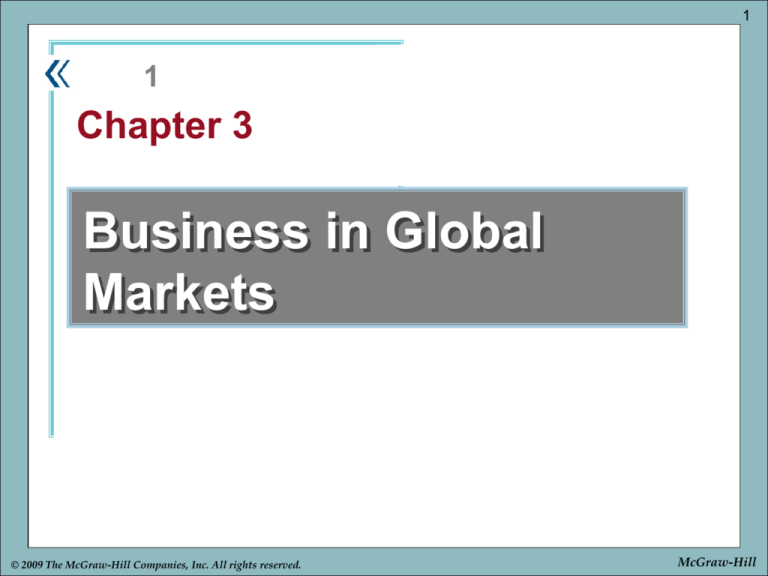
1
part 1
Chapter 3
Chapter
Business in Global
Markets
© 2009 The McGraw-Hill Companies, Inc. All rights reserved.
McGraw-Hill
2
Learning Objectives
1. Define global business.
2. Understand the importance of global trade.
3. Discuss the roles of comparative and absolute
advantage in global trade.
4. Discuss the two indicators for measuring global
trade.
5. Describe different types of trade protections and
trade agreements.
6. Discuss the different strategies for reaching global
markets.
7. Explain the forces affecting the global trade
market.
McGraw-Hill
© 2009 The McGraw-Hill Companies, Inc. All rights reserved.
3
Understanding Globalization
• Global business
• Cultural changes
Global Trade
• US vs. Global Market
• Thomas Friedman – “The World is Flat”
• Exporting and Importing
Why Trade Globally?
• Reasons to trade
• Free trade
McGraw-Hill
© 2009 The McGraw-Hill Companies, Inc. All rights reserved.
4
Comparative Advantage and
Absolute Advantage
• Global trade
• David Ricardo’s comparative advantage
theory
• Absolute advantage
– Difficult to sustain
McGraw-Hill
© 2009 The McGraw-Hill Companies, Inc. All rights reserved.
5
Measuring Trade
Balance of Payments and Trade Deficits
• Two key factors
– Balance of trade
• Trade surplus/deficit
– Balance of payments
Unfair trade Practices
• Dumping
• Gray Market
McGraw-Hill
© 2009 The McGraw-Hill Companies, Inc. All rights reserved.
6
Trade Protection and Agreements
• Trade protectionism
• Two kinds of tariff
– Protective
– Revenue
• Import quota
• Embargo
• Non-tariff barriers
– Keiretsu
McGraw-Hill
© 2009 The McGraw-Hill Companies, Inc. All rights reserved.
7
Trade Protection and Agreements
The General Agreement on Tariffs and Trade
and the WTO
• General Agreement on Tariffs and Trade
(GATT)
• World Trade Organization (WTO)
Common Markets
• European Union (EU)
• Mercosur
McGraw-Hill
© 2009 The McGraw-Hill Companies, Inc. All rights reserved.
8
Trade Protection and Agreements
Organization of the Petroleum Exporting
Countries (OPEC)
• 12 member organization’s mission:
– Coordinate & unify policies
– Ensure price stability
– Provide efficient & regular supply
McGraw-Hill
© 2009 The McGraw-Hill Companies, Inc. All rights reserved.
9
Trade Protection and Agreements
North American Free Trade Agreement
(NAFTA)
• Objectives
–
–
–
–
–
Eliminate trade barriers
Promote conditions of fair competition
Increase investment opportunities
Provide protection & enforcement
Establish framework
• Success and difficulties
McGraw-Hill
© 2009 The McGraw-Hill Companies, Inc. All rights reserved.
10
Strategies for Reaching Global Markets
McGraw-Hill
© 2009 The McGraw-Hill Companies, Inc. All rights reserved.
11
Strategies for Reaching Global Markets
Licensing
• Additional revenues
• Extended timeframe
• Firm may lose secrets
Exporting
• Export Assistance Centers (EACs)
• Export Trading Companies
Franchising
• Franchise Agreement (Franchisor & Franchisee)
• Product adaptation
McGraw-Hill
© 2009 The McGraw-Hill Companies, Inc. All rights reserved.
12
Strategies for Reaching Global Markets
Contract Manufacturing
• Outsourcing
• Experiment in new markets and/or meet unexpected
increase in orders
• Major disadvantage: Laws are different
International Joint Ventures and Strategic
Alliance
• Benefits
– Shared technology, marketing, risk, market entry
• Greenfield investment
• Strategic alliance
McGraw-Hill
© 2009 The McGraw-Hill Companies, Inc. All rights reserved.
13
Strategies for Reaching Global Markets
Foreign Direct Investment
• Foreign subsidiary
• Expropriation
• Multinational corporation
McGraw-Hill
© 2009 The McGraw-Hill Companies, Inc. All rights reserved.
14
Forces Affecting Trade in Global Markets
Socio-cultural Forces
– Culture
– Ethnocentricity
• Religion
– Most important of socio-cultural forces
• Human resource management
– Employee training on culture
• Communication
– Global marketing
– “Think global, act local.”
McGraw-Hill
© 2009 The McGraw-Hill Companies, Inc. All rights reserved.
15
Forces Affecting Trade in Global Markets
Economic and Financial Forces
• Exchange rate
• Bartering
• Counter-trading
McGraw-Hill
© 2009 The McGraw-Hill Companies, Inc. All rights reserved.
16
Forces Affecting Trade in Global Markets
Legal and Regulatory Forces
• No central law in global markets
Physical and Environmental Forces
• Technological constraint
The Future of Global Trade
• Advanced communication
• Unprecedented growth
McGraw-Hill
© 2009 The McGraw-Hill Companies, Inc. All rights reserved.






